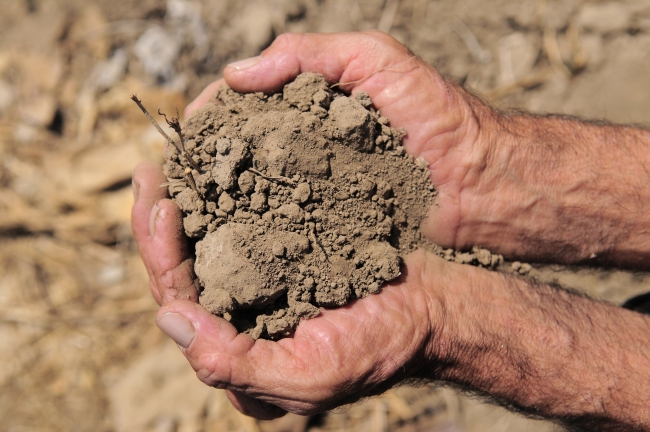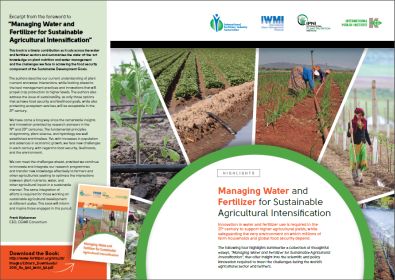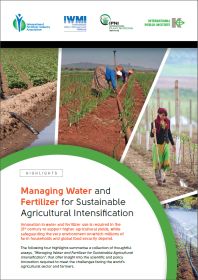How smarter fertilizer and water use can help sustain our soils
April 19th – 23rd is Global Soil Week 2015, a time to take stock of the value of soil. As experts gather in Berlin for to discuss ways to ensure this vital resource is managed sustainably, we take a look at how smart fertilizer and water use can help.

Urea fertilizer is a superb source of nitrogen for boosting crop production. The only problem is that it doesn’t always wind up where it’s intended.
Annually, a staggering 100 to 200 million tonnes of urea worth USD 30 to 60 billion is washed away from agricultural soils into freshwater supplies (an estimate based on data in a UN-backed report). As we know well, excess nitrogen can over-stimulate algae growth, depriving fish and other organisms of the oxygen they need. Nitrate contamination of drinking water can be especially harmful to infants (blue baby syndrome) and young livestock.
These are some of the reasons why one of the key recommendations from the United Nations (UN) is to improve nutrient use efficiency in crop production. A new reference book, Managing water and fertilizer for sustainable agricultural intensification, presents guidelines on how to achieve just that while giving equal attention to water-use efficiency – a link with fertilizer use which is often overlooked.
This reference guide was published by the International Fertilizer Industry Association (IFA), with contributions from researchers of the International Water Management Institute (IWMI) and other experts.
The new book comes at a time when a new set of development goals to improve the livelihoods of poor people is being launched – the Sustainable Development Goals (SDGs), as a successor to the UN Millennium Development Goals (MDGs). Two of the 17 proposed SDGs are related to water and plant nutrient issues: food security and improving nutrition. This is also the International Year of Soils, as declared by the 68th UN General Assembly.
“As agriculture moves into an era with greater uncertainties because of climate change, it will be critical to implement new and best water management and nutrient-delivery strategies that increase food production, water-use efficiency and minimize environmental impacts,” said Jennie Barron, Theme Leader – Sustainable Agricultural Water Management, IWMI.
According to IFA, fertilizer use has soared fivefold, globally, in the past five decades. In 2012, about 180 million tonnes of fertilizer were applied, at an average application rate of 115 kg of nutrients per hectare of arable land and crops. Fertilizer use varies widely across the globe, from relatively low rates in sub-Saharan Africa to high levels in East Asia.
Agriculture accounts for 70% of all water withdrawals from aquifers, streams and lakes. However, in the past, water and fertilizer have been addressed separately, resulting in inefficient and unsustainable fertilizer use, as evidenced by chemical runoff. Yet, to sustain a population projected to grow from 7 to 9 billion by 2050, the world must increase crop, fodder and fiber production.
[pullquote type=”pullquote3″ content=”up to 70% to 80% of nitrogen added to the soil is lost in rainfed farms, and 60% to 70% is lost in irrigated fields” quote_icon=”yes” align=”right” textcolor=”#289f2d”]up to 70% to 80% of nitrogen added to the soil is lost in rainfed farms, and 60% to 70% is lost in irrigated fields[/pullquote]The reference guide notes more efficient options such as fertigation – the delivery of water and dissolved nutrients to crops at the same time. The editors also stress the ‘4Rs’ – right fertilizer, right application rate, right time and right place.
Pay Drechsel, Theme Leader – Resource Recovery, Water Quality and Health, IWMI, and co-editor of the book, emphasized the need for smart nutrient and water management to avoid pollution and over-extraction of water: “This book summarizes key experiences on how to use your inputs wisely.”
Fertilizer dates back a century to the work of Fritz Haber and Carl Bosch in converting nitrogen from the atmosphere into ammonia compounds used to nourish plants. In his book, Enriching the Earth, Canadian scientist Vaclav Smil argued that the Haber-Bosch process “has been of greater fundamental importance to the modern world than the airplane, nuclear energy, spaceflight or television.”
Much of the extraordinary growth in agricultural productivity during the past 50 years has been fueled by ever-higher applications of nitrogen. However, there are also areas, such as in Scandinavian countries, which have increased crop yields while using less fertilizer in recent decades through, for example, no-till farming that boosts the cycling of water and nutrients in the soil.
This reference book cites data from farmer plots around the world, which indicate that up to 70% to 80% of nitrogen added to the soil is lost in rainfed farms, and 60% to 70% is lost in irrigated fields. By contrast, researcher-managed plots with precision farming techniques can cut the loss of nutrients, such as nitrogen and potassium, by more than half.
According to the editors, the main challenge today is for rainfed farms, where water and nutrient management is often far from optimum due to rainfall variability. Managing this variability with water storage and other techniques, along with providing balanced nutrient delivery, can counter productivity issues.
Researchers state that many farmers do not practice balanced fertilization, due to a lack of knowledge, financial capacity or logistical constraints. Improvements will require a major, coordinated effort by groups providing advice on fertilizer application, especially to smallholder farmers.
[one-half 1]

[/one-half]
[one-half 2]

[/one-half]
[hr-border top=”no”/]
Pay Drechsel is Theme Leader – Resource Recovery, Water Quality and Health at the International Water Management Institute (IWMI), Colombo, Sri Lanka.
Read the report:
Drechsel, P.; Heffer, P.; Magen, H.; Mikkelsen, R.; Wichelns, D. (Eds.) 2015. Managing water and fertilizer for sustainable agricultural intensification. 1st ed. Paris, France: International Fertilizer Industry Association (IFA); Colombo, Sri Lanka: International Water Management Institute (IWMI); Georgia, USA: International Plant Nutrition Institute (IPNI); Horgen, Switzerland: International Potash Institute (IPI). 270p.
This work is supported by the CGIAR Research Program on Water, Land and Ecosystems (WLE).

